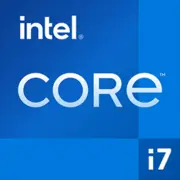Intel Core i7-5775C

Intel Core i7-5775C Broadwell: 2025年の包括的レビュー
(2025年4月現在)
1. 主な特性: アーキテクチャ、プロセス技術、重要な特徴
2015年に発売されたIntel Core i7-5775Cプロセッサーは、その当時のユニークな技術により、今でも関心を引き続けています。
Broadwellアーキテクチャと14nmプロセス技術
このチップは、14ナノメートルプロセス技術を使用したBroadwellマイクロアーキテクチャ(Coreの第5世代)に基づいています。これにより、65WのTDP(熱設計電力)でエネルギー消費を抑えつつ、高いパフォーマンスを維持しています。先代(Haswell)と比べて、BroadwellはIPC(サイクルあたりの命令)を5〜10%向上させており、特にシングルスレッドのタスクで顕著です。
4コア、8スレッド、キャッシュ
プロセッサは4つのコアを持ち、Hyper-Threadingにより8つのスレッドをサポートしています。6MBのL3キャッシュを搭載しており、2025年のGeekbench 6テストでは以下のスコアを示します:
- シングルスレッド: 1410ポイント
- マルチスレッド: 4832ポイント。
比較として、現代のRyzen 5 5500(6コア/12スレッド)は、約1600/6000ポイントを達成しますが、価格は180ドルからです。
主な特徴
- Iris Pro Graphics 6200 — eDRAM(128MB)を搭載した統合グラフィックス。Intel UHDの基本的なソリューションを上回り、720pでのゲーム(例えば、低設定のCS:2)にも対応。
- PCIe 3.0サポート — NVMe SSD用のアダプターに対応。
- エネルギー効率 — コンパクトなシステムに最適。
2. 対応マザーボード: ソケットとチップセット
LGA1150: 2025年の選択肢は限られる
プロセッサはLGA1150ソケットを使用しています。対応するチップセットは以下の通りです:
- H97/Z97 — オーバークロック用(Z97のみ);
- H81/B85 — PCIe 3.0をサポートしない低価格帯。
モデルの例:
- ASUS Z97-A(在庫価格:120〜150ドル) — オーバークロック対応、DDR3スロット4つ;
- Gigabyte H97-D3H(80〜100ドル) — ベーシックな安定性。
選択のポイント:
- 互換性のためにBIOSのアップデートを確認してください。
- M.2スロットを備えたマザーボードを探してください(NVMe用のアダプターが必要)。
3. 対応メモリ: DDR3Lと隠れた制限
プロセッサはDDR3L-1600MHz(公式)またはDDR3(非公式、最大1.5Vまでの電圧制限)で動作します。
- 最大容量: 32GB(4×8GB);
- 推奨: ゲームやマルチタスク用に最適な容量は16GB(2×8GB)。
重要: DDR4/DDR5はサポートされていません。最新のメモリが必要な場合、このプロセッサは適しません。
4. 電源ユニット: 推奨出力
65WのTDPを持ちながらも、ディスクリートGPU(例えば、GTX 1660)と組み合わせても500W電源ユニットで十分です:
- 予算モデル: EVGA 500 W1(45ドル) — 基本構成向け;
- プレミアムモデル: Corsair CX550M(80ドル) — モジュラー設計、80 Plus Bronze認証。
アドバイス: ハイエンドGPU(RTX 3060以上)を搭載する場合は、600W以上の電源ユニットを選んでください。
5. 2025年におけるi7-5775Cの長所と短所
長所:
- エネルギー効率 — HTPCやミニPCに適しています。
- Iris Pro Graphics — オフィス作業や軽いゲームのためにディスクリートGPUは不要。
- マルチスレッド性能 — Blenderでのレンダリングやビデオコーディングにおける8スレッド。
短所:
- 古くなったプラットフォーム — DDR4、PCIe 4.0、USB 3.2 Gen 2のサポートがない。
- アップグレードが限られている — LGA1150の最大はXeon E3-1285 v4またはi7-4790K。
- 新しいモデルの価格 — 珍しさから150〜200ドル。
6. 使用シナリオ: ゲーミング、仕事、マルチメディア
ゲーム
- CS:2、Dota 2、GTA V — Iris Pro 6200での中設定で60FPSを実現;
- ディスクリートGPU(RTX 3050)を使用すれば、2023〜2024年のAAAタイトルで1080p/Ultra設定が可能。
作業タスク
- フォトエディタ(Photoshop): RAWファイルの高速処理。
- ビデオ編集(Premiere Pro): 1080p動画を許容範囲内でレンダリング。
マルチメディア
- HDMI 1.4経由での4Kストリーミング;
- 低いTDPによる静かな動作。
7. 競合他社との比較
Intel Core i7-6700K (Skylake)
- 長所: DDR4サポート、IPC向上、2025年に入手しやすい。
- 短所: 高価格(180〜220ドル)、eDRAMなし。
AMD Ryzen 5 1600 (2017)
- 長所: 6コア/12スレッド、Ryzen 5000へのアップグレード可能なAM4プラットフォーム。
- 短所: ディスクリートGPUが必要。
結論: i7-5775Cはエネルギー効率や統合グラフィックスで勝りますが、マルチスレッド性能では劣ります。
8. ビルドのアドバイス
- 古いPCのアップグレード用: LGA1150マザーボードがあれば良い選択です。
- 新規ビルド: NVMe SSD用のM.2アダプターを備えたB85/H97を選ぶ(例:Samsung 970 EVO)。
- 冷却: ボックスクーラーまたは低価格のクーラー(Deepcool Gammaxx 400)が十分です。
400ドルのビルド例:
- CPU: i7-5775C(160ドル);
- マザーボード: ASUS H97-PLUS(100ドル);
- RAM: DDR3 16GB(50ドル);
- SSD: Kingston A2000 500GB(60ドル);
- PSU: EVGA 500 W1(45ドル)。
9. 最終的な結論: 2025年にi7-5775Cが適するのは誰か?
このプロセッサーは以下のような方に適しています:
1. 予算ビルドの愛好者 — LGA1150プラットフォームが既にある場合。
2. コンパクトPC愛好者 — 低TDPとIris Proのおかげで。
3. 中古市場 — DDR5/AM5への移行前の一時的な解決策として。
代替案: 新しいシステムを検討する場合は、Ryzen 5 5500やCore i3-13100Fを選ぶと、より良いパフォーマンスと最新の技術を提供します。
もしi7-5775Cが150ドル未満で見つけられ、古いPCを生かしたいのであれば、これは優れた選択肢です。しかし、将来的なアップグレードを計画している場合は、最新のプラットフォームへの移行を考えてください。
基本
CPUの仕様
メモリ仕様
GPUの仕様
その他
ベンチマーク
他のCPUとの比較
ソーシャルメディアで共有する
または当サイトへのリンクを追加
<a href="https://cputronic.com/ja/cpu/intel-core-i7-5775c" target="_blank">Intel Core i7-5775C</a>